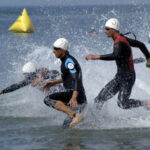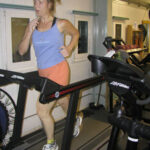Having successfully trained for and competed in an Olympic distance triathlon, I have learned many tricks which will help beginner triathletes.
Each event: the swim, the bike and the run are entities unto themselves, so in this article I will only cover things I’ve learned in the swim portion of the triathlon.
As I stated, I compete in the Olympic distances which means the swim is a 1 mile open water swim.
The swim can be intimidating for beginner triathletes because it is the biggest unknown. Everyone has a basic idea of how to ride a bike and run, but swimming isn’t something we do every day.
It’s a given that triathletes need to train to be good swimmers, or at least passable swimmers.
The best place to start training for open water swims is in a lap pool. Start out slow going 3 times a week and slowly adding more and more laps. Start out doing 5 to 10 laps.
You’ll find your lap swimming stamina will quickly build. You may feel awful the first few times, but keep with it and soon you’ll be busting out 30 laps without trouble.
Once you’re comfortable swimming 33 laps (there and back equals 1 lap), which is nearly a mile in a 25 yard pool, that’s when you need to step it up.
Most likely you’re training for a triathlon where the swim takes place in a lake, or even the ocean. The first thing to do is invest in a triathlon specific wetsuit. You don’t want a regular stiff wetsuit; these things will wear you out in a hurry. You may end up having to spend a couple hundred bucks, but they’re worth every penny.
Now it’s time to head to a lake and swim with all your gear on. You’ll need a swim cap, earplugs, nose plugs and a good pair of non-fogging swim goggles.
Most likely you’re training for a summer triathlon, which means you’re swimming in the Spring when the lakes are cold.
With your wetsuit on, ease into the water but don’t start swimming immediately. Let your wetsuit work on warming the water next to your skin. Put your head under water, feel the shock of cold on your face, get used to it.
Once you’re comfortable, start swimming. Don’t go full tilt though, keep it smooth and easy. You’ll be amazed how incredible the triathlon wetsuit works. You float high and feel like you’re a speed boat.
Don’t swim too hard, continue with easy strokes. Concentrate on your breathing. If you feel yourself getting short of breath try to work through it by slowing down. If it gets too bad come up but continue breast stroking. Once you’re under control continue with the freestyle stroke.
I was amazed on my first lake swim, how different it was from the pool. I thought it would be a natural transition from the pool to the lake, but I was wrong. I got about 5 minutes into the swim and I went into a panic as I lost my breath and had to tread water until I calmed down. It was humiliating and shattered my confidence.
I didn’t let it stop me though; I went out the next day and tried again, following the above guidelines. Things went much smoother, and I got a full workout in. If I hadn’t gone to the lake before competing in the triathlon, I probably wouldn’t have finished the race.
Be sure to do at least 3 lake swims before your triathlon. Practice lifting your head and spotting the shore about every 5th stroke.
Figure out which method of breathing is best for you. In the pool I take 3 strokes then breathe on the right, then take 3 more strokes and breathe on the left. I found that during the triathlon I was much more comfortable if I breathed on every stroke. It worked for me and allowed me to swim harder.
Swimming style is very different for each swimmer be sure you figure out your best practice before your triathlon.
To follow my triathlon training see my blog.





